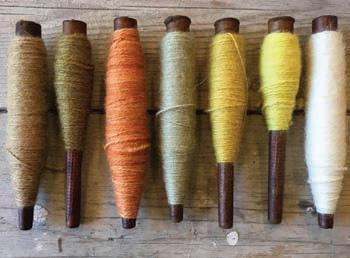
4 minute read
FORAGING FOR COLOUR
Foraged colour
Natural dyes are sustainable by definition, derived from products sourced from our natural environment, such as leaves, bark, fungi and flowers. Linda Row has developed the concept into a collaborative project involving four textile artists and the results can soon be seen in an exhibition called Foraged Colour, says Emma Clegg
Advertisement
Three local textile artists have collaborated on an Arts Council funded project investigating local, sustainable, and contemporary garment production. Gill Hewitt, who specialises in needlepunch textiles, and weaver Penny Wheeler, both based in Bath, and Eve Kumari from Bradford-on-Avon are textile artists who have collaborated with weaver Frances Westerduin from t he North West Highlands and Linda Row who works with sustainable clothing and textile production.
This project, which will culminate in a touring exhibition called Foraged Colour, is a development of Linda’s vision of fashion as a closed-loop, sustainable industry using locally grown and foraged materials for dyeing yarn and utilising local production. The project exemplifies a closed loop system – where the same materials are used over and over again to create new products for purchase – addressing the issues surrounding fast fashion and the energyrich transport system of global fashion.
The exhibition will also encourage conversations on themes such as climate change, localism, embodied energy, ethical consumption and sustainability.
The starting point was the creation of hand-dyed wool with natural dye col ours made from locally foraged plants and fungi. Linda Row explains, “This project is a culmination of research that I have carried out, looking at the myriad of natural sources to obtain colour from, some of which are documented and others pure experimentation.
“I started with Brunello’s (1973) comprehensive list of plants that he recorded from historical dye documents and I identified the ones that could b e found locally. This led to a fascination with the colours that could be achieved by simply walking outside the front door, such as marjoram, hollyhock, gunnera, beech, oak
Frances Westerduin designed a twill check using natural fleece colour yarn as a contrast to the dyed yarns
and mahonia. I started to trial leaves, barks, fungi and flowers and the collection turned into boxes and boxes of dried materials.
“As a sustainable designer in 2020, I have decided to confront the issue of endless air-miles that curr ent clothing production involves and set a challenge to limit fibre, colour and making to the UK.”
The wool was sourced from British sheep and has been spun in the United Kingdom. Gill, Penny, Eve and Frances have created unique, handmade woven and non-woven textiles from the dyed wool. Linda then designed and constructed garments from the artisan textiles.
The touring exhibition – with full details still to be announced – will show audiences the surprising range of materials that can be sustainably foraged to create colour using traditional dyeing practices in a modern context. Visitors will be able to experience some of the making process with touch samples of textiles and a film offering a commentary on each artist’s involvement.
❝I became fascinated with the colours that could be achieved [from local plants], such as marjoram, hollyhock, gunnera, beech, oak and mahonia ❝
Gill Hewitt’s inspiration often comes from sources within the structures and rh ythms of nature, particularly the degradation of materials over time and the transient effects of light and shadows. It was the autumnal reflections of trees in the river that influenced the colour palette for the Foraged Colour Coat shown opposite, and its texture was inspired by lichen growing on coastal rocks. “The Foraged Colour project particularly appealed to me as sustainability has always been an im portant part of my working practice – I keep even the smallest scraps of fabric and use them in more detailed pieces of work, and nothing is wasted. I loved learning the processes involved in making and using natural dyes,” said Gill.
Weaver and artist Penny Wheeler, who works on a countermarch loom, pushes the
Eve Kumari designed her woven fabric to work alongside Linda Row’s unique pattern for the garment, which was constructed in six sections of woven panels

boundaries of weaving to explore ideas of landscape and loves to experiment with a variety of yarns and three-dimensional woven structures. Penny took her initial inspiration from the idea of foraging and its timelessness, reflected in European folk and fairy tales. For this collaboration, Penny’s initial drawn designs and Linda’s fashion drawing led to the idea of juxtaposing autumn and spring forest colours in the different panels of the dress. In total Linda dyed over 50 natural and foraged colours, a nd Penny had to weave two exactly matching drops of fabric.
Penny explained, “The project enabled me to think much more deeply about making my practice more sustainable through my experimentation with British wools, the range of natural and foraged dyes available, and a greater awareness of waste.”
Eve Kumari incorporated her extra weft technique into the project, which achieved a modern take on natural dye ing. By precisely working out the amount of yarn needed and weaving narrow strips, there was very little waste.
Workshops to accompany the exhibition will offer examples of eco-dyeing and upcycling; extending the concept of foraging to include used items in charity shops. Workshops at Westonbirt Arboretum will be taking place – check for updates on the website. n










